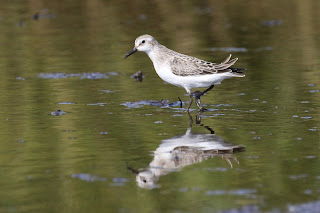Time for regular blog posts is at an all time low and will remain so!
It is the thick of shorebird migration - one of my favourite groups of birds - so Alison and I headed down the shore with a focus on these subtly charming birds.
Check out these two plovers:
Notice how the one in the back seems slightly larger, the black facial markings are more complete, and the black band across the forehead stands out more from the sandy brown head.
As you may have guessed, they're two different species. Semipalmated Plover in front (a very common species in NL) and Common Ringed Plover at back (the needle in the haystack). Seeking out these subtle differences is a unique kind of challenge that I absolutely love (and others, understandably, think is deranged).
After scrutinizing 3503 (yes, eBird counts every single one for me!) Semi Plovers, a CR Plover really does stand out from the crowd. When you see one you know it right away! It's just a matter of getting the photos to feel satisfied and document this rarity.
This adult (probably a male) Common Ringed Plover was at Portugal Cove South yesterday and was about the 18th record for the island of Newfoundland (but already the third or fourth one this year - there is one pending review from Branch)!
There are many intricate features to distinguish these two species, which I won't go into here. Check out the finer details here.
One that is often mentioned is the more prominent white wing bar as compared to that of a Semi Plover. I'm not sure I could ever consistently pick this out in flight, but it is evident in most photos.
Common Ringed Plovers are often the bully on the beach chasing around the wimpy Semi Plovers!
The other shorebird highlight of the day were not 1, but 3 Stilt Sandpipers! I've never seen one in Newfoundland before, so obviously a lot were migrating this week and were driven off course by the remnants of hurricane Gert and the associated low pressure system.
Most Semipalmated Sandpipers these days are juveniles:
Two tame Red Crossbills were busy feeding on the oceanside in Cappahayden:



























































